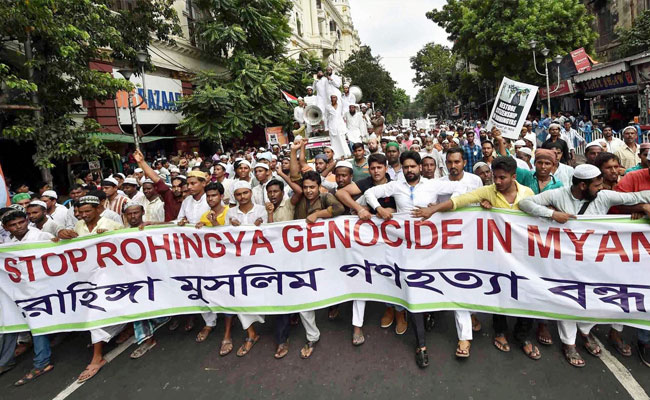Rohingyas are a miniscule Muslim minority in faraway Myanmar that were long engaged in bloody warfare with Burmese authorities. Unlike other Burmese ethnic groups, which include the Christian Karen, Kachin and Chin minorities, the Rohingya aren’t even ethnically Burmese. They are ethnic Bengalis whose forefathers migrated to Rakhine state of Myanmar centuries ago. At the time of India’s partition and independence, the Rohingyas had wished to be separated from Burma and attached to Pakistan. When that demand failed, the Rohingyas engaged in decades of insurgency against the native Buddhist population of Rakhine state of Myanmar.
By 1982, Burma had declared Rohingyas as non-citizens. Counter-insurgency by Burmese forces resulted in thousands of Rohingyas being forced out of Myanmar as stateless refugees. In recent times, renewed hostilities between ethnic Buddhist Rakhines and Rohingyas has resulted in many more Rohingyas being forced out of Myanmar. Even now, a combination of action by Burmese army and the hostile reaction by native Buddhists continues to force Rohingyas to flee Burma. Strangely, some 40,000 or so Rohingyas made India their home. Of these, several thousand ended up in Jammu city.
It is pertinent to note that Jammu & Kashmir has restrictive settlement laws in order to protect the state’s demography. In view of reports of the Rohingyas acting as a potential fifth column and a serious security threat, the current government has expressed its inclination to show the door to Rohingya refugees. This has resulted in a veritable storm, with the Opposition and Liberals accusing the government of not living upto India’s great humanitarian record.
To add to this political melee, massive rallies were held across the country by Muslim groups on 11th September, a massive rally by Muslim groups in Kolkata brought the city to a halt for nearly 4 hours. In addition to criticizing the Burmese government, the Central government was castigated for suggesting a deportation of all Rohingyas living illegally in the country. A similar rally in Tripura saw attendance of Muslim groups demanding food and shelter to be arranged for Rohingyas. As if that weren’t enough, Muslim groups in Jammu & Kashmir also loudly protested against the treatment being meted out to Rohingyas, both in Myanmar and in India. Protest were witnessed even in Lucknow, where fortunately, a mention of genocide of Hindus in Rakhine state was also made.
What is interesting to note is that the Muslims of Bengal, J&K, UP, Tripura etc. have nothing to do with the Rohingyas per se. Rohingyas have never been an Indian Muslim community, so to speak.
Why is it then that many Indian Muslims and the Indian Muslim ‘leadership’, crying themselves hoarse about the treatment of Rohingyas? Don’t they have better things to worry about? For instance, literacy levels in their community, or some regressive social practices followed by Indian Muslims or rights of women, or economic emancipation of the community etc. If nothing else, they could focus their attention towards the imaginary deterioration in the plight of Muslims under the Modi government. But instead, they choose to focus on the far away Rohingyas, with whom they share no social or cultural ties.
It is an outright lie that such protests are guided merely by enlightened ideals of humanitarianism. The spectre of Pan-Islamism emerged on the global scene in the aftermath of the First World War. When the Entente Powers decided to strip the Sultan of Turkey, the nominal Caliph of Islam and disband his caliphate, all of a sudden hell broke loose. India, which was overwhelmingly Hindu was drowned in riots and violence at this decision of the Western powers. Khilafat movement rocked the country. Even in distant Malabar, which had nothing to do with Turkey or its Caliph, murderous riots saw Hindus being killed, their women folk being raped and forcible conversions becoming the norm. Indian Muslims had nothing to do with the Sultan of Turkey.
In practice, the Caliphate was as imaginary as the blue moon. The Muslim community, the Ummah, had never been united ever since the advent of Islam and ever since the Shia-Sunni schism, Indian Muslims had more in common with their Iranian brethren than the distant Turks and yet Indian Muslims revolted and agitated against the mistreatment of the Turkish Sultan. Even in modern times, the cause of Palestinian Arabs arouses more sympathy and tears among a section of Indian Muslims than say the plight of Kashmiri Pandits. Hindus and Sikhs in Pakistan and Bangladesh are left to their fate but the harassment of Muslims by Trump evokes much anxiety.
Pan-Islamism is a false ideal that many Indian Muslims continue to worship. Islam, like all other living religions is highly stratified. Aside from the Shia-Sunni divide, Islam in spite of it being claimed that it is a uniform monolith, has many divisions and sub divisions, resulting from centuries of interaction and mingling of different peoples.
Indian Muslims, for instance, have much more in common with their Hindu and Sikh neighbours than Muslims in Arabia. Central Asian Muslims relate more to the Iranians in spite of differences in their faiths and so on.
Some Indian Muslims are doing a great disservice to themselves by continuing to uphold the cause of foreigners, merely because of a superficial similarity in their religions and ignoring the obvious threat such an association brings to their motherland. The support to Rohingyas by a section of Indian Muslims must be seen in this light.
